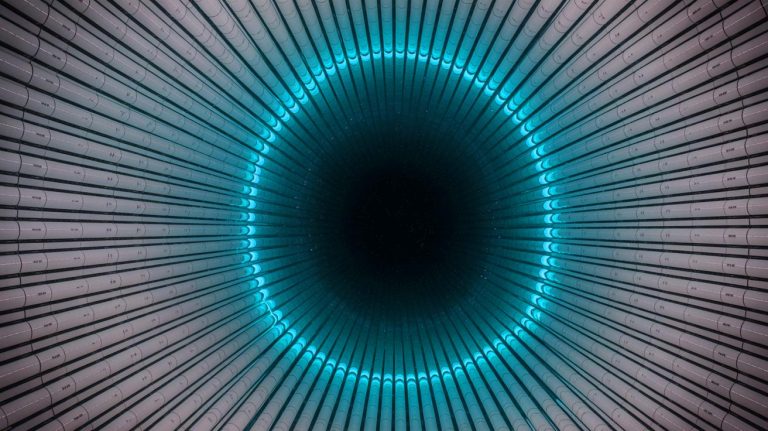| IN A NUTSHELL |
|
Deep beneath Mount Ikeno in Japan, a groundbreaking scientific endeavor is unfolding. The Super-Kamiokande, a colossal neutrino detector, stands as a testament to human ingenuity in unraveling the mysteries of the universe. This massive experiment, housed in a chamber equivalent to a 15-story building, is designed to capture the most elusive particles in existence—neutrinos. As these subatomic particles traverse the cosmos with barely any interaction with matter, they hold the keys to understanding some of the universe’s most explosive phenomena, such as supernovae. This article delves into the incredible world of the Super-Kamiokande and its pivotal role in modern astrophysics.
The Unseen World of Neutrinos
Neutrinos are among the most mysterious and fascinating particles in the universe. Traveling at nearly the speed of light, they pass through ordinary matter almost undisturbed, earning descriptions such as “the most elusive prey in the cosmos” by renowned astrophysicists like Neil deGrasse Tyson. The challenge lies in their detection, as they can pass through a hundred light-years of steel without any interaction. Despite this, neutrinos are fundamentally important, offering insights into some of the most violent cosmic events, such as supernovae—the explosive death throes of massive stars. Before a star collapses into a black hole, it emits a vast number of neutrinos. Super-Kamiokande is one of the few instruments capable of detecting these particles, providing early warnings and valuable data on these cataclysmic occurrences. As Dr. Yoshi Uchida of Imperial College London explains, without such detectors, we would miss the crucial neutrino signals preceding a supernova event in our galaxy.
A Deep Dive into Super-Kamiokande’s Lab
Super-Kamiokande is an engineering marvel situated 3,280 feet underground, designed to detect the near-invisible neutrinos. The detector is filled with an astonishing 50,000 tons of ultra-pure water, crucial for picking up the fleeting signals produced by neutrinos. When these particles move through the water faster than light can travel in the medium, they create a shockwave of light known as Cherenkov radiation. This phenomenon is captured by the lab’s 11,000 highly sensitive Photo Multiplier Tubes, or PMTs, which detect the faint bursts of light. Dr. Uchida likens this to the sonic boom of an airplane exceeding the speed of sound, illustrating the unique ability of Super-Kamiokande to observe what is otherwise invisible. This facility not only contributes to our understanding of supernovae but also plays a significant role in other particle physics experiments.
The Role of Ultra-Pure Water
The water used in Super-Kamiokande is extraordinary in its clarity and purity, essential for detecting neutrinos. However, its remarkable purity comes with challenges. Dr. Uchida warns of the dangers, noting that this water behaves like both an acid and an alkaline, capable of dissolving metals and leaching nutrients from organic matter. Dr. Matthew Malek of the University of Sheffield recounts a personal experience where the ultra-pure water extracted nutrients from his hair, causing an intense itchiness. Such anecdotes underscore the delicate balance scientists must maintain to ensure the water remains uncontaminated, as even the slightest impurities can skew the sensitive measurements necessary for detecting neutrinos.
A System to Detect the Death of Stars
Beyond detecting neutrinos from supernovae, Super-Kamiokande plays a vital role in the T2K experiment, which sends neutrinos across Japan to study their oscillations. This research helps scientists understand why matter exists, despite the equal creation of matter and anti-matter at the universe’s beginning. As Dr. Morgan Wascko of Imperial College London points out, the disappearance of anti-matter is one of the universe’s great mysteries. Super-Kamiokande offers the strongest evidence yet of the differences in behavior between matter and anti-matter, contributing to our understanding of the universe’s composition. The detector, through its various roles, continues to advance our knowledge of fundamental physics and the universe.
As the Super-Kamiokande continues its mission beneath Mount Ikeno, it not only deepens our understanding of neutrinos but also enriches our comprehension of the universe’s most enigmatic phenomena. With each particle detected, scientists inch closer to unraveling the secrets of the cosmos. What other mysteries might these elusive particles hold, and how will they continue to shape our understanding of the universe in the future?
Did you like it? 4.4/5 (26)





Wow, a candle on the moon? That’s some insane technology! 🚀
Can someone explain what Cherenkov radiation is in layman’s terms?
This is fascinating! Thanks for sharing such groundbreaking research! 😊
How did they manage to get 50,000 tons of ultra-pure water underground? 🤔
I find it hard to believe that neutrinos can be detected. Are they really that elusive?
Are there any practical applications for this kind of research?
So, are they really using water that can dissolve metals? Sounds dangerous! 😲
The technology sounds cool, but what’s the point if we can’t see these neutrinos?
Why is the lab located under a mountain? Is that necessary for the experiment?